Determining forest carbon sequestration capacity by remote sensing – GIS combined with quick measurement method (Case study in Que Phong district, Nghe An province)
The article clarifies the potential for payment for forest environment in
the study area, focusing on the carbon sequestration services. Remote sensing -
Geographic information system (GIS) method is used in research to map land cover,
identify and update forest status. The fieldwork method in combination the quick
measurement method was used to identify the sample plots and calculate forest
biomass. The research results have shown the great carbon sequestration potential of
the study area. This is an opportunity to enhance the value of payment for forest
services when implementing carbon markets in the study area.
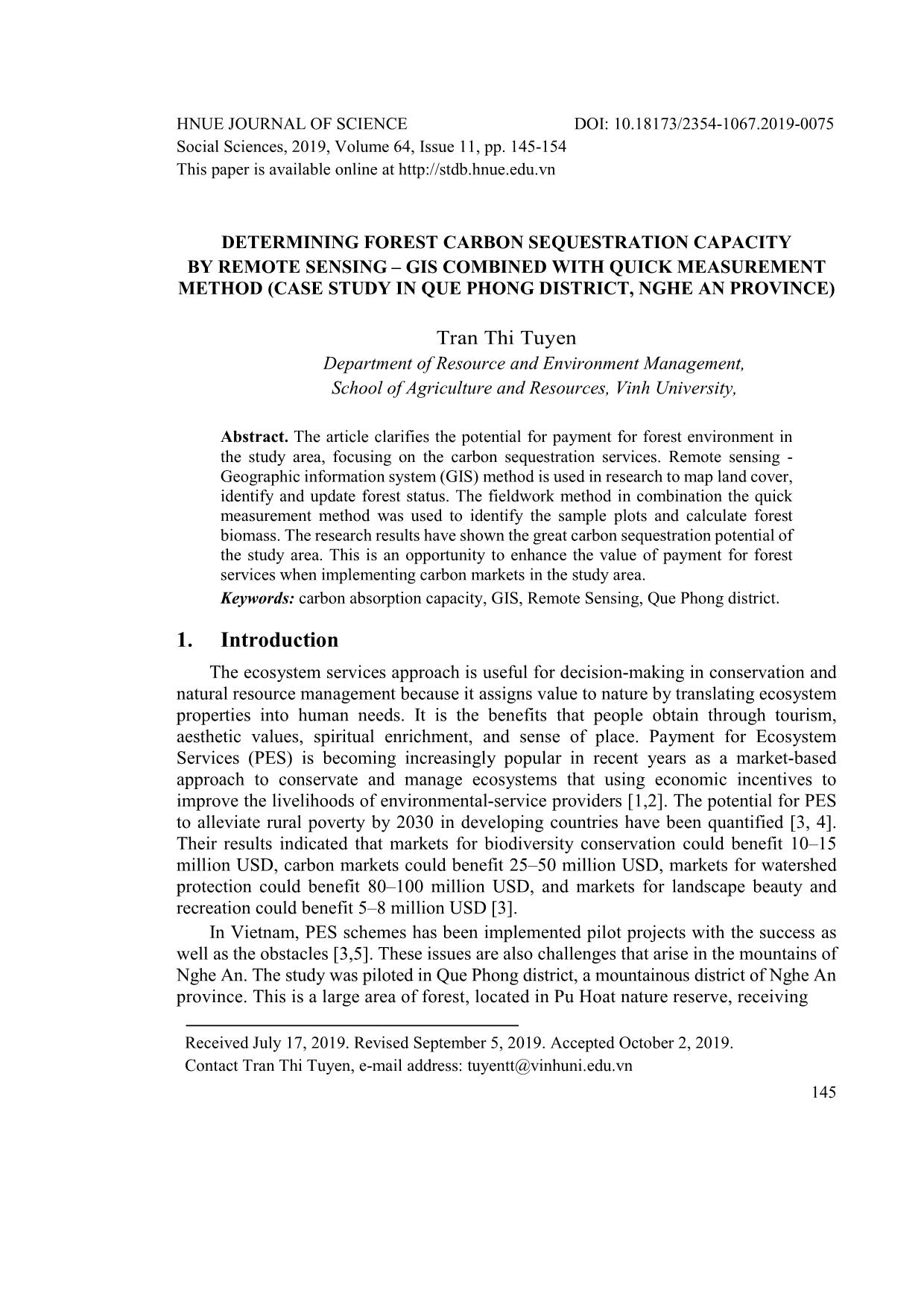
Trang 1
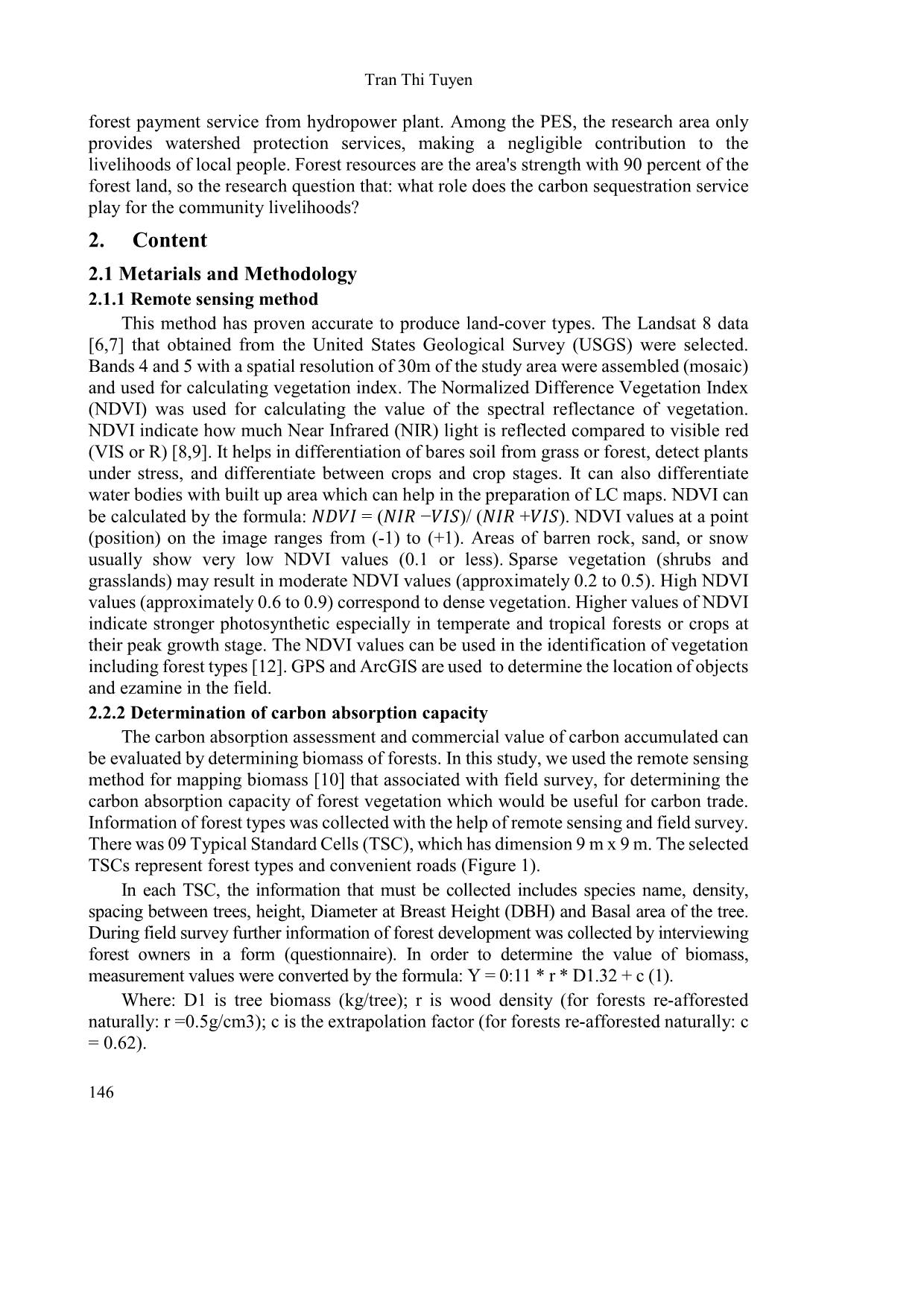
Trang 2
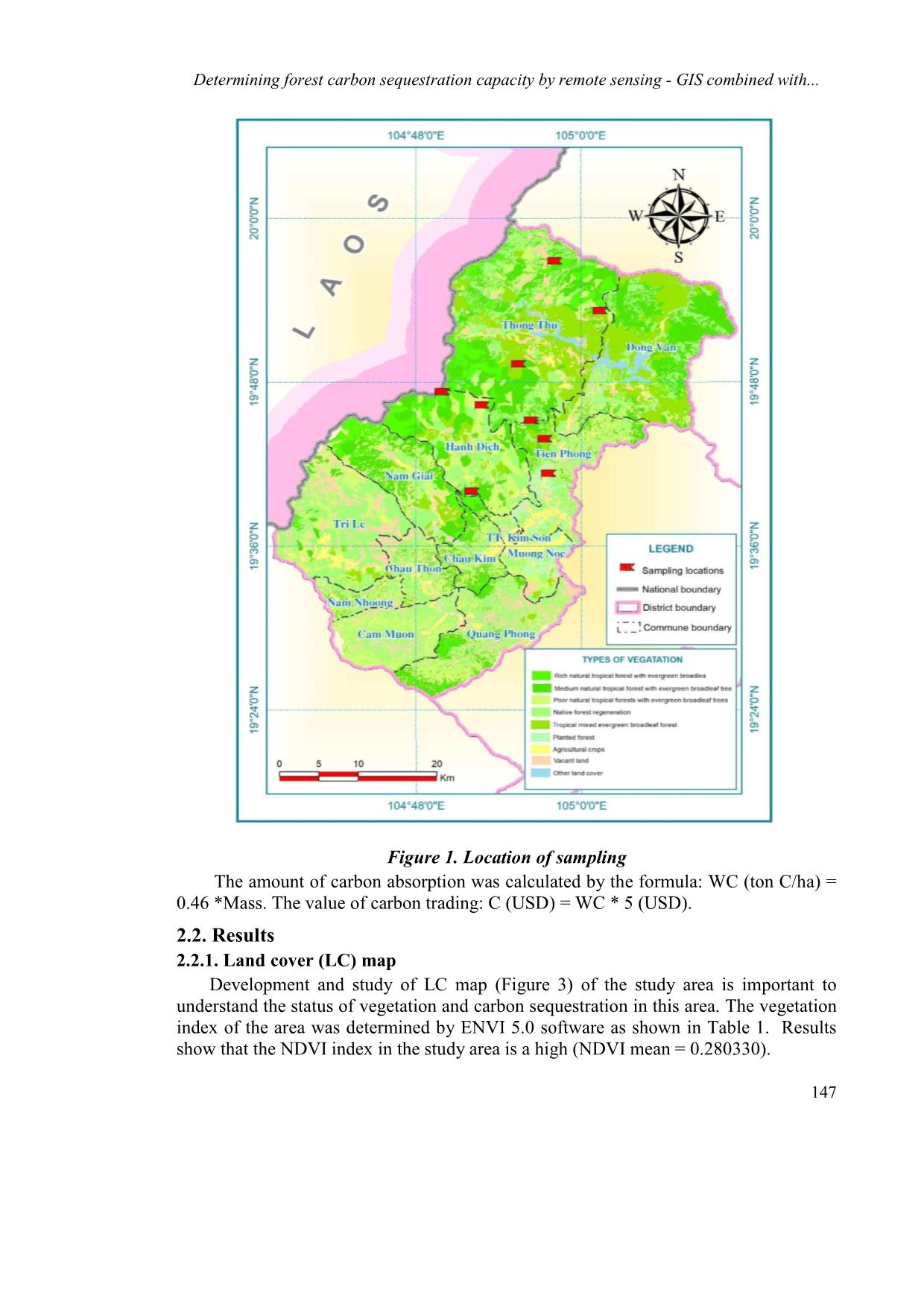
Trang 3
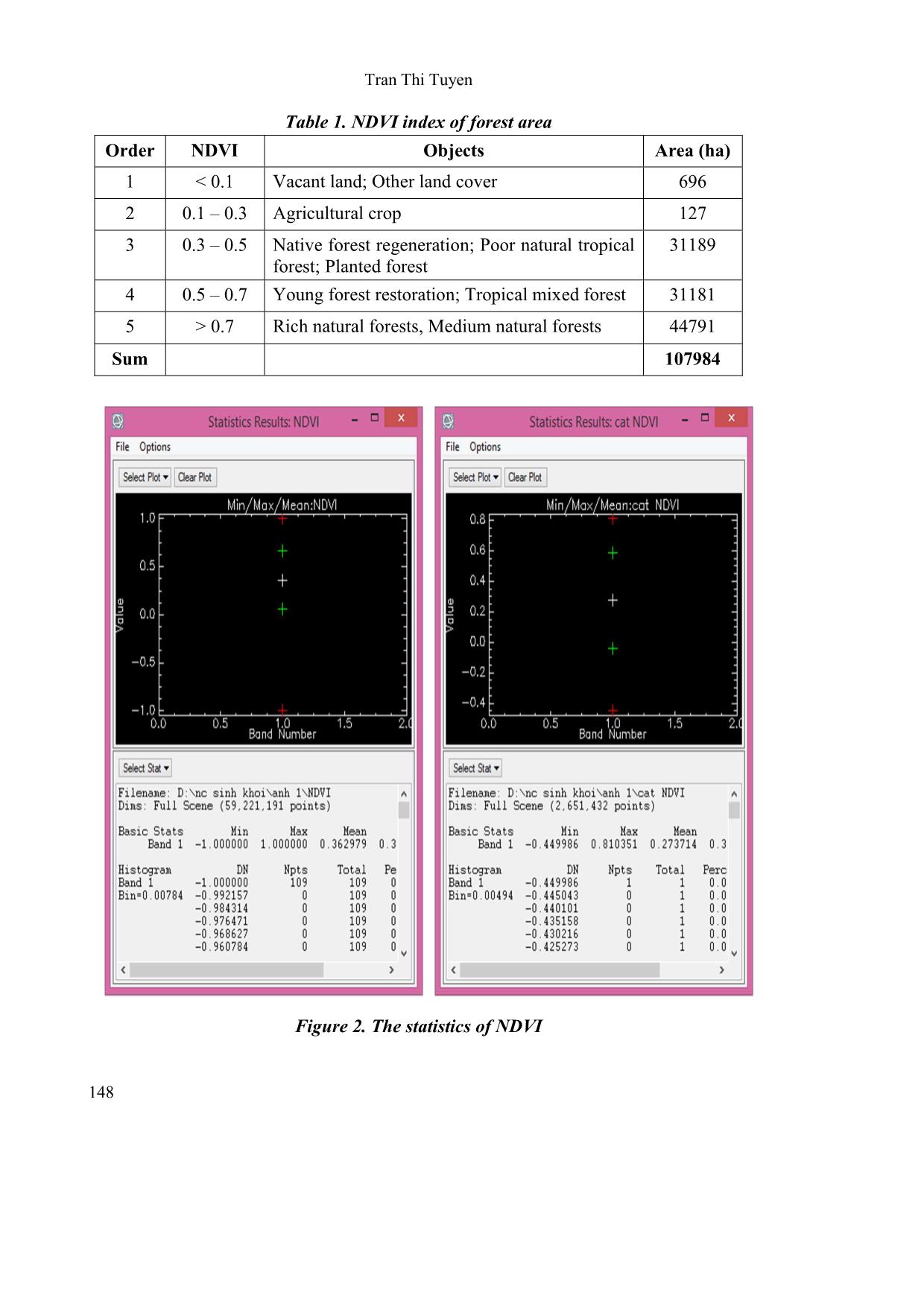
Trang 4
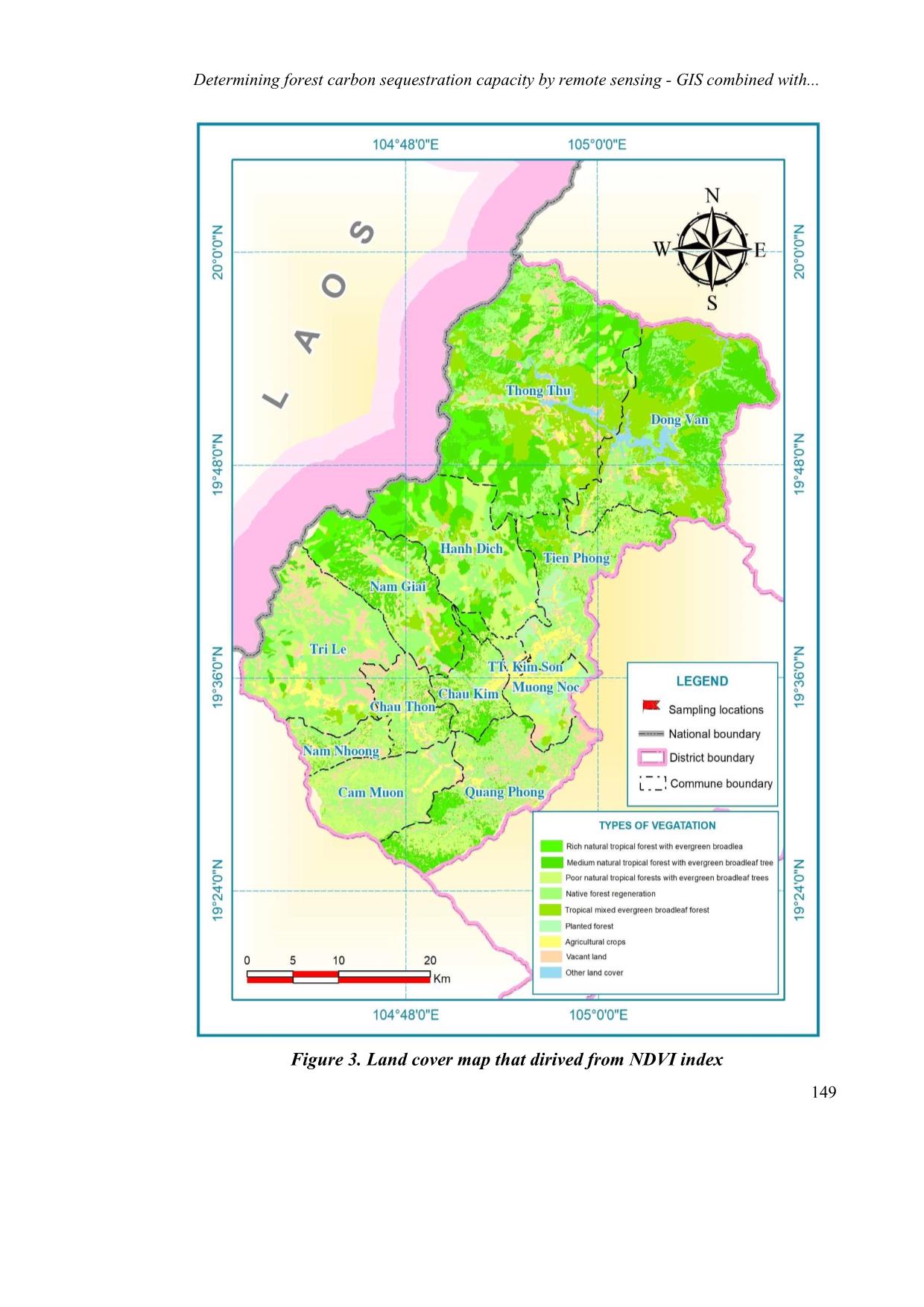
Trang 5
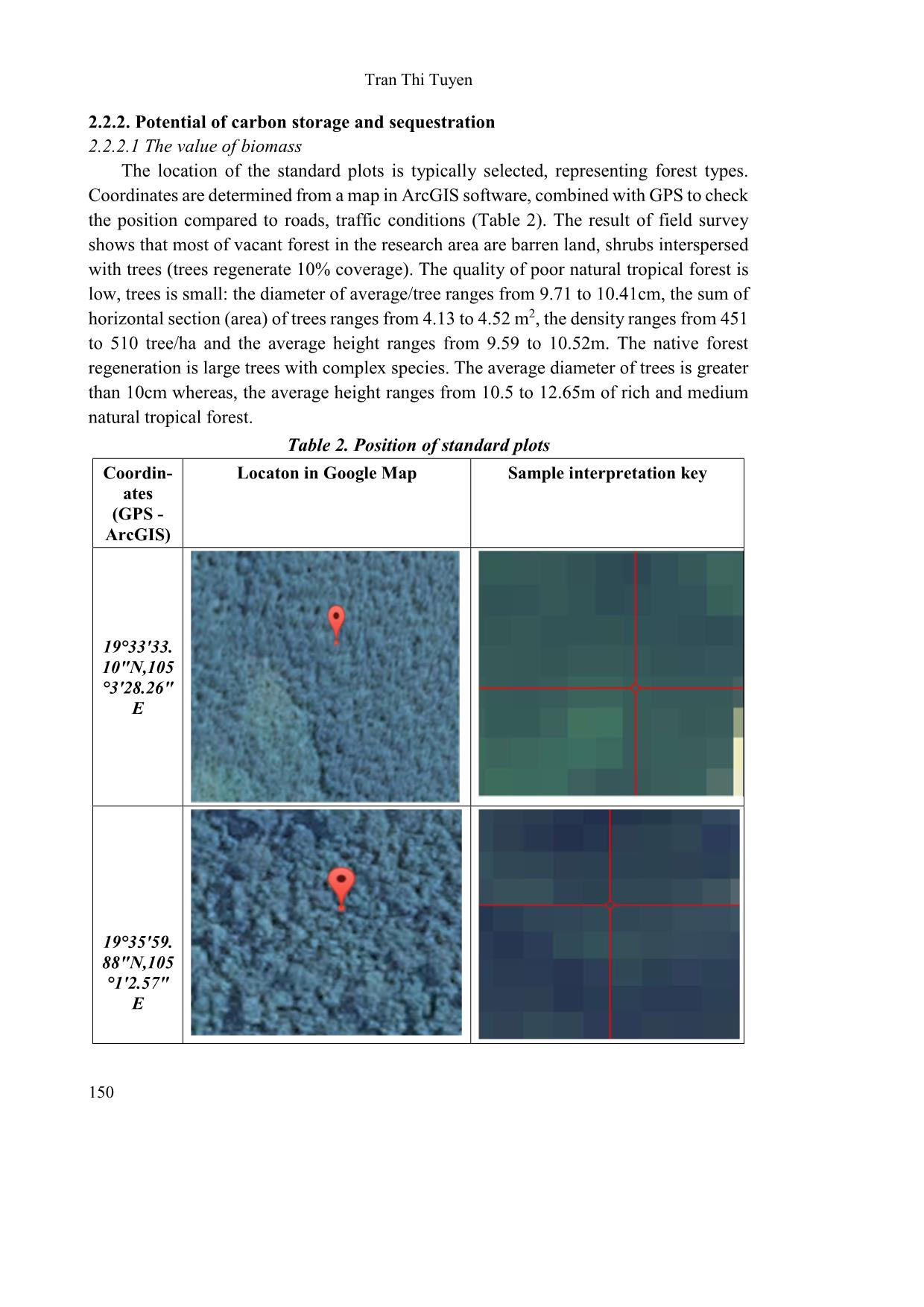
Trang 6
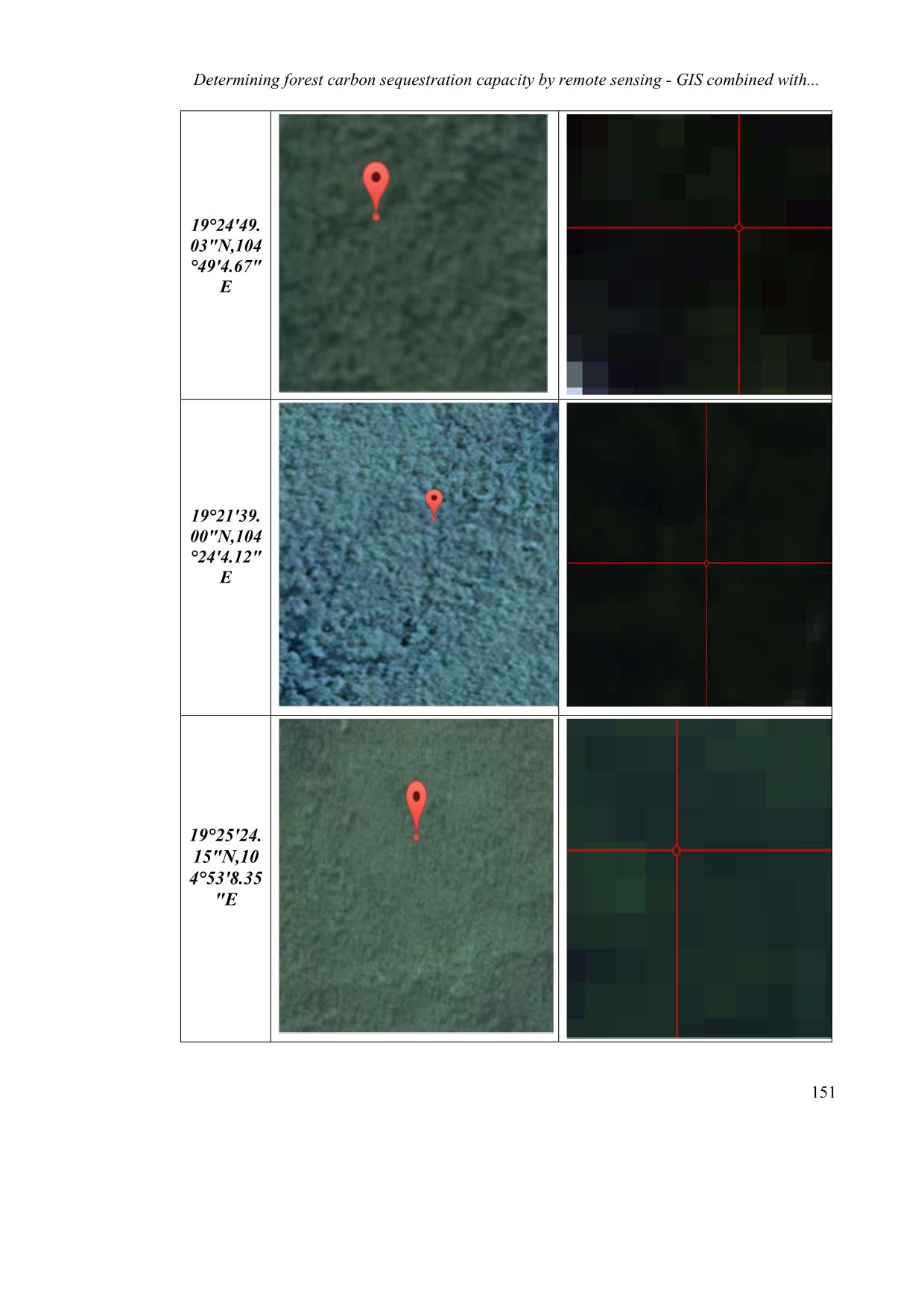
Trang 7
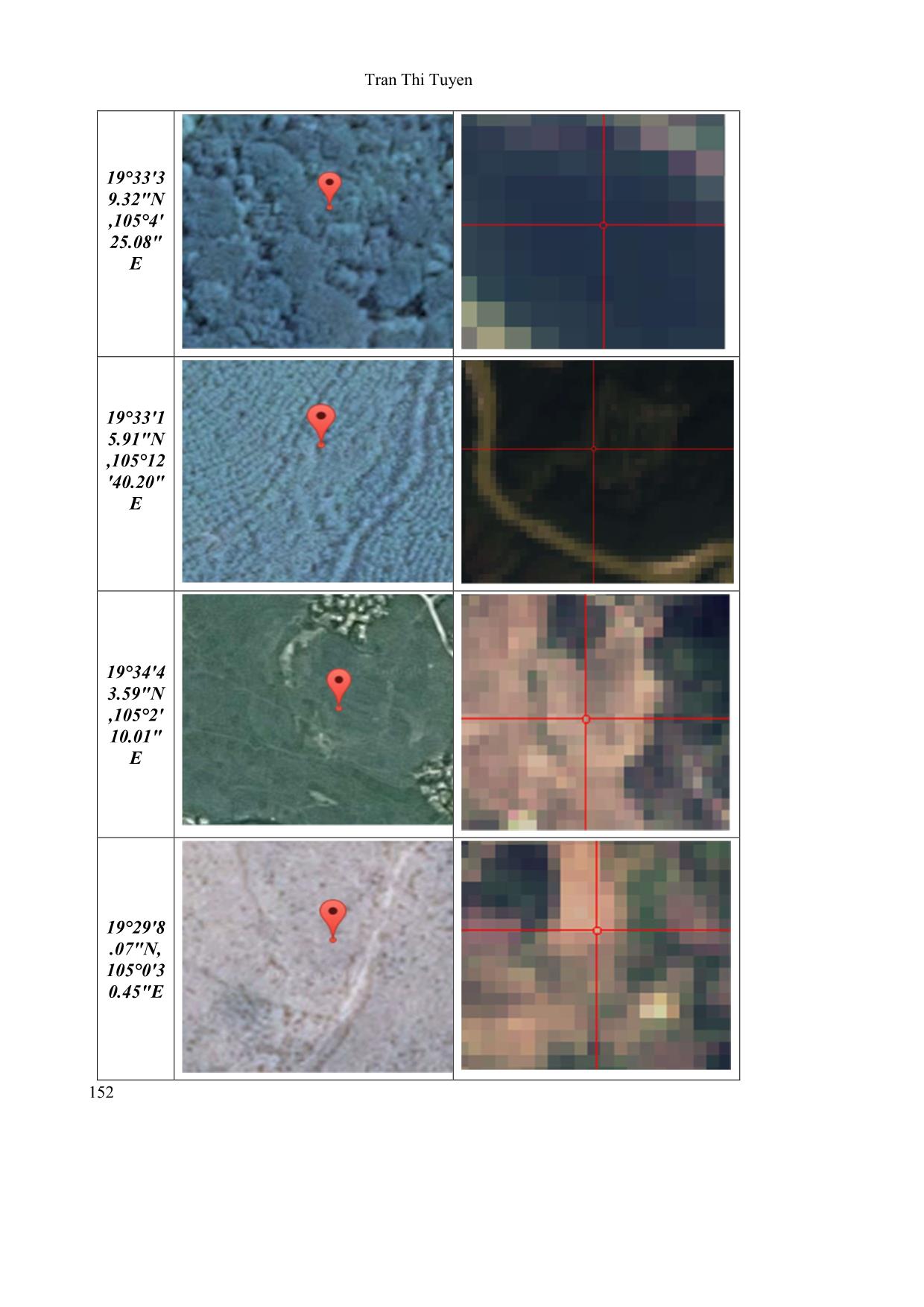
Trang 8
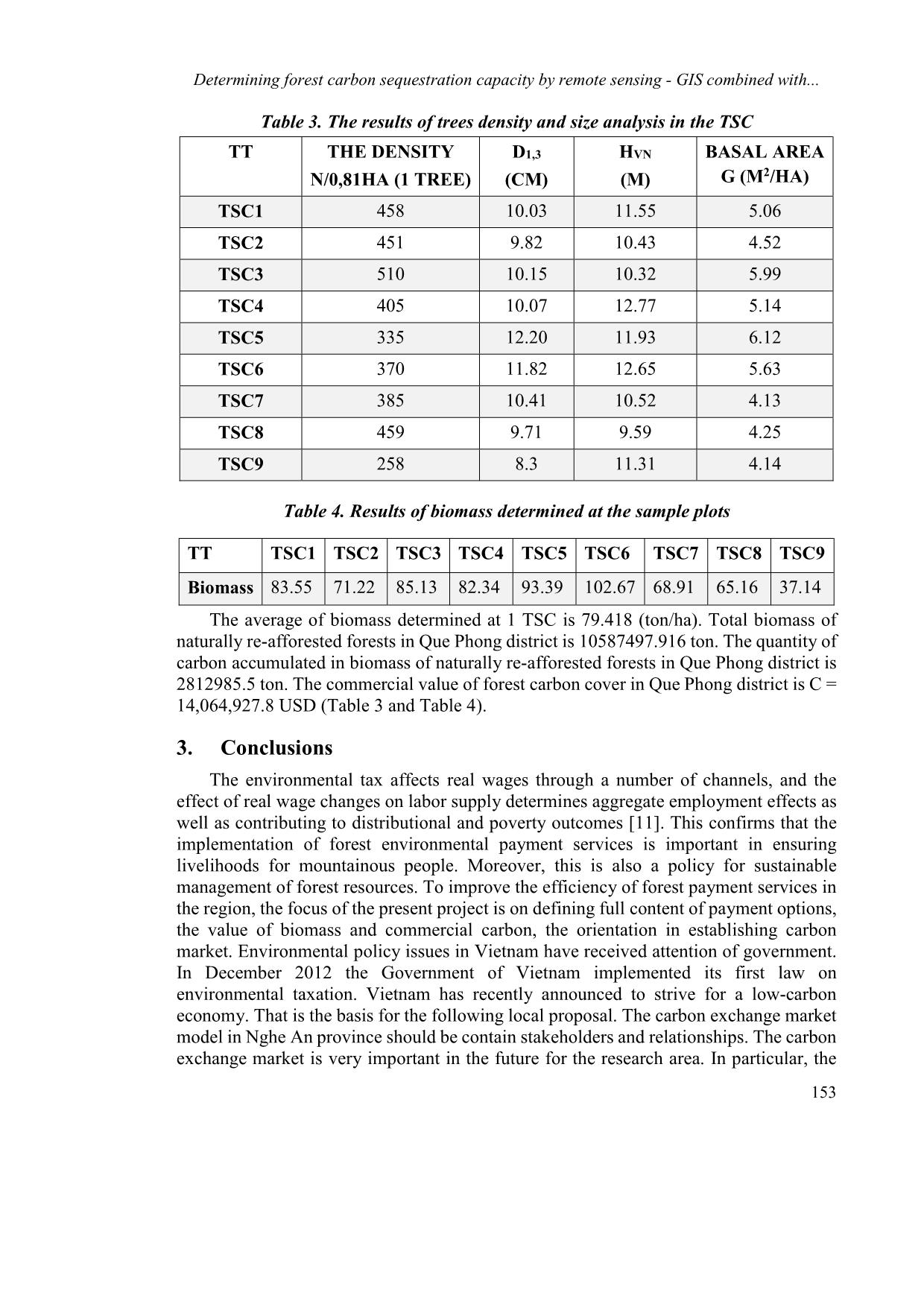
Trang 9
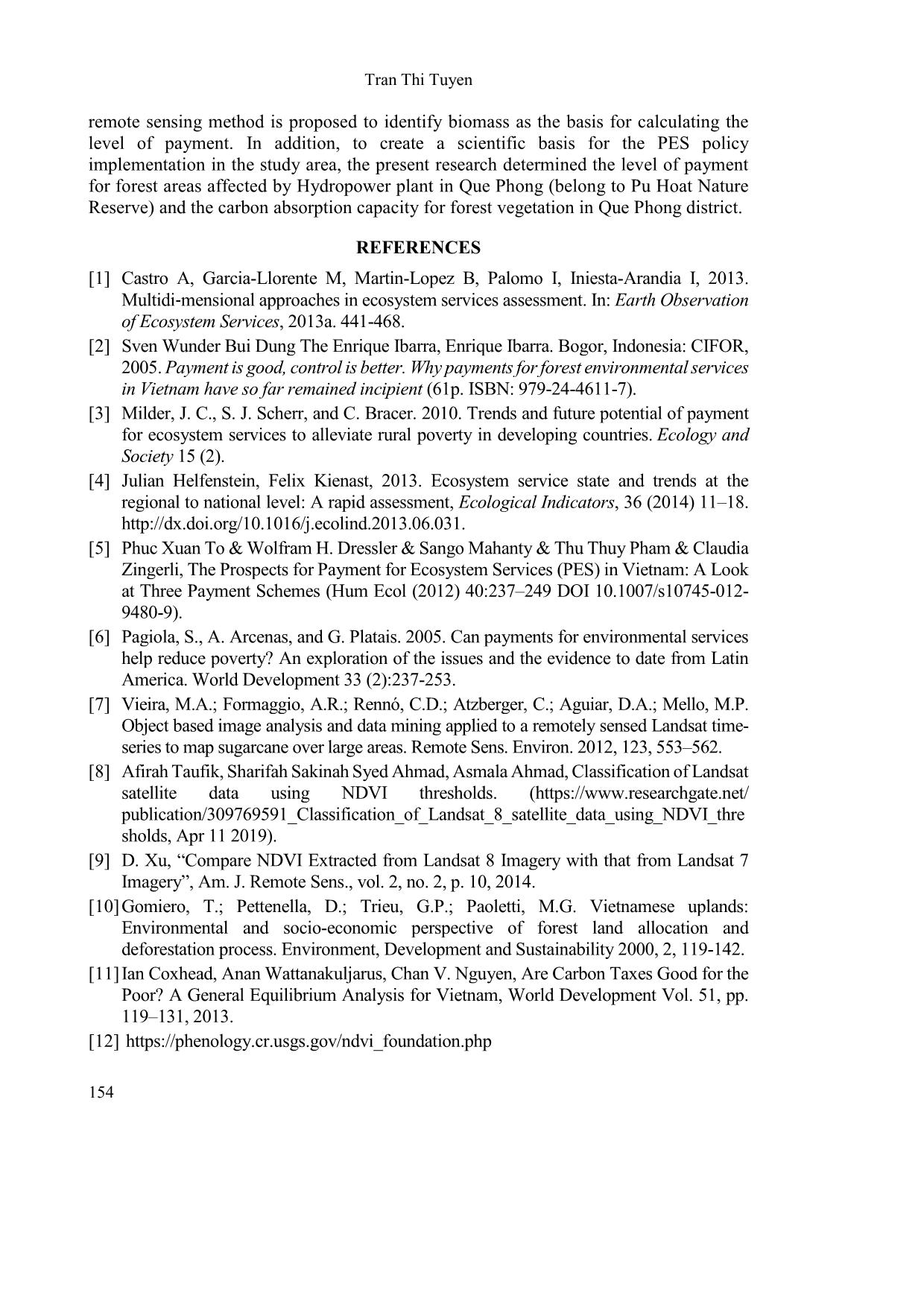
Trang 10
Bạn đang xem tài liệu "Determining forest carbon sequestration capacity by remote sensing – GIS combined with quick measurement method (Case study in Que Phong district, Nghe An province)", để tải tài liệu gốc về máy hãy click vào nút Download ở trên
Tóm tắt nội dung tài liệu: Determining forest carbon sequestration capacity by remote sensing – GIS combined with quick measurement method (Case study in Que Phong district, Nghe An province)
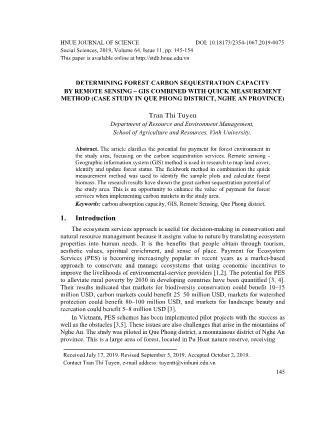
HNUE JOURNAL OF SCIENCE DOI: 10.18173/2354-1067.2019-0075 Social Sciences, 2019, Volume 64, Issue 11, pp. 145-154 This paper is available online at DETERMINING FOREST CARBON SEQUESTRATION CAPACITY BY REMOTE SENSING – GIS COMBINED WITH QUICK MEASUREMENT METHOD (CASE STUDY IN QUE PHONG DISTRICT, NGHE AN PROVINCE) Tran Thi Tuyen Department of Resource and Environment Management, School of Agriculture and Resources, Vinh University, Abstract. The article clarifies the potential for payment for forest environment in the study area, focusing on the carbon sequestration services. Remote sensing - Geographic information system (GIS) method is used in research to map land cover, identify and update forest status. The fieldwork method in combination the quick measurement method was used to identify the sample plots and calculate forest biomass. The research results have shown the great carbon sequestration potential of the study area. This is an opportunity to enhance the value of payment for forest services when implementing carbon markets in the study area. Keywords: carbon absorption capacity, GIS, Remote Sensing, Que Phong district. 1. Introduction The ecosystem services approach is useful for decision-making in conservation and natural resource management because it assigns value to nature by translating ecosystem properties into human needs. It is the benefits that people obtain through tourism, aesthetic values, spiritual enrichment, and sense of place. Payment for Ecosystem Services (PES) is becoming increasingly popular in recent years as a market-based approach to conservate and manage ecosystems that using economic incentives to improve the livelihoods of environmental-service providers [1,2]. The potential for PES to alleviate rural poverty by 2030 in developing countries have been quantified [3, 4]. Their results indicated that markets for biodiversity conservation could benefit 10–15 million USD, carbon markets could benefit 25–50 million USD, markets for watershed protection could benefit 80–100 million USD, and markets for landscape beauty and recreation could benefit 5–8 million USD [3]. In Vietnam, PES schemes has been implemented pilot projects with the success as well as the obstacles [3,5]. These issues are also challenges that arise in the mountains of Nghe An. The study was piloted in Que Phong district, a mountainous district of Nghe An province. This is a large area of forest, located in Pu Hoat nature reserve, receiving Received July 17, 2019. Revised September 5, 2019. Accepted October 2, 2019. Contact Tran Thi Tuyen, e-mail address: tuyentt@vinhuni.edu.vn 145 Tran Thi Tuyen forest payment service from hydropower plant. Among the PES, the research area only provides watershed protection services, making a negligible contribution to the livelihoods of local people. Forest resources are the area's strength with 90 percent of the forest land, so the research question that: what role does the carbon sequestration service play for the community livelihoods? 2. Content 2.1 Metarials and Methodology 2.1.1 Remote sensing method This method has proven accurate to produce land-cover types. The Landsat 8 data [6,7] that obtained from the United States Geological Survey (USGS) were selected. Bands 4 and 5 with a spatial resolution of 30m of the study area were assembled (mosaic) and used for calculating vegetation index. The Normalized Difference Vegetation Index (NDVI) was used for calculating the value of the spectral reflectance of vegetation. NDVI indicate how much Near Infrared (NIR) light is reflected compared to visible red (VIS or R) [8,9]. It helps in differentiation of bares soil from grass or forest, detect plants under stress, and differentiate between crops and crop stages. It can also differentiate water bodies with built up area which can help in the preparation of LC maps. NDVI can be calculated by the formula: = ( 푅 − 푆)/ ( 푅 + 푆). NDVI values at a point (position) on the image ranges from (-1) to (+1). Areas of barren rock, sand, or snow usually show very low NDVI values (0.1 or less). Sparse vegetation (shrubs and grasslands) may result in moderate NDVI values (approximately 0.2 to 0.5). High NDVI values (approximately 0.6 to 0.9) correspond to dense vegetation. Higher values of NDVI indicate stronger photosynthetic especially in temperate and tropical forests or crops at their peak growth stage. The NDVI values can be used in the identification of vegetation including forest types [12]. GPS and ArcGIS are used to determine the location of objects and ezamine in the field. 2.2.2 Determination of carbon absorption capacity The carbon absorption assessment and commercial value of carbon accumulated can be evaluated by determining biomass of forests. In this study, we used the remote sensing method for mapping biomass [10] that associated with field survey, for determining the carbon absorption capacity of forest vegetation which would be useful for carbon trade. Information of forest types was collected with the help of remote sensing and field survey. There was 09 Typical Standard Cells (TSC), which has dimension 9 m x 9 m. The selected TSCs represent forest types and convenient roads (Figure 1). In each TSC, the information that must be collected includes species name, density, spacing between trees, height, Diameter at Breast Height (DBH) and Basal area of the tree. During field survey further information of forest development was collected by interviewing forest owners in a form (questionnaire). In order to determine the value of biomass, measurement values were converted by the formula: Y = 0:11 * r * D1.32 + c (1). Where: D1 is tree biomass (kg/tree); r is wood density (for forests re-afforested naturally: r =0.5g/cm3); c is the extrapolation factor (for forests re-afforested naturally: c = 0.62). 146 Determining forest carbon sequestration capacity by remote sensing - GIS combined with... Figure 1. Location of sampling The amount of carbon absorption was calculated by the formula: WC (ton C/ha) = 0.46 *Mass. The value of carbon trading: C (USD) = WC * 5 (USD). 2.2. Results 2.2.1. Land cover (LC) map Development and study of LC map (Figure 3) of the study area is important to understand the status of vegetation and carbon sequestration in this area. The vegetation index of the area was determined by ENVI 5.0 software as shown in Table 1. Results show that the NDVI index in the study area is a high (NDVI mean = 0.280330). 147 Tran Thi Tuyen Table 1. NDVI index of forest area Order NDVI Objects Area (ha) 1 < 0.1 Vacant land; Other land cover 696 2 0.1 – 0.3 Agricultural crop 127 3 0.3 – 0.5 Native forest regeneration; Poor natural tropical 31189 forest; Planted forest 4 0.5 – 0.7 Young forest restoration; Tropical mixed forest 31181 5 > 0.7 Rich natural forests, Medium natural forests 44791 Sum 107984 Figure 2. The statistics of NDVI 148 Determining forest carbon sequestration capacity by remote sensing - GIS combined with... Figure 3. Land cover map that dirived from NDVI index 149 Tran Thi Tuyen 2.2.2. Potential of carbon storage and sequestration 2.2.2.1 The value of biomass The location of the standard plots is typically selected, representing forest types. Coordinates are determined from a map in ArcGIS software, combined with GPS to check the position compared to roads, traffic conditions (Table 2). The result of field survey shows that most of vacant forest in the research area are barren land, shrubs interspersed with trees (trees regenerate 10% coverage). The quality of poor natural tropical forest is low, trees is small: the diameter of average/tree ranges from 9.71 to 10.41cm, the sum of horizontal section (area) of trees ranges from 4.13 to 4.52 m2, the density ranges from 451 to 510 tree/ha and the average height ranges from 9.59 to 10.52m. The native forest regeneration is large trees with complex species. The average diameter of trees is greater than 10cm whereas, the average height ranges from 10.5 to 12.65m of rich and medium natural tropical forest. Table 2. Position of standard plots Coordin- Locaton in Google Map Sample interpretation key ates (GPS - ArcGIS) 19°33'33. 10"N,105 °3'28.26" E 19°35'59. 88"N,105 °1'2.57" E 150 Determining forest carbon sequestration capacity by remote sensing - GIS combined with... 19°24'49. 03"N,104 °49'4.67" E 19°21'39. 00"N,104 °24'4.12" E 19°25'24. 15"N,10 4°53'8.35 "E 151 Tran Thi Tuyen 19°33'3 9.32"N ,105°4' 25.08" E 19°33'1 5.91"N ,105°12 '40.20" E 19°34'4 3.59"N ,105°2' 10.01" E 19°29'8 .07"N, 105°0'3 0.45"E 152 Determining forest carbon sequestration capacity by remote sensing - GIS combined with... Table 3. The results of trees density and size analysis in the TSC TT THE DENSITY D1,3 HVN BASAL AREA N/0,81HA (1 TREE) (CM) (M) G (M2/HA) TSC1 458 10.03 11.55 5.06 TSC2 451 9.82 10.43 4.52 TSC3 510 10.15 10.32 5.99 TSC4 405 10.07 12.77 5.14 TSC5 335 12.20 11.93 6.12 TSC6 370 11.82 12.65 5.63 TSC7 385 10.41 10.52 4.13 TSC8 459 9.71 9.59 4.25 TSC9 258 8.3 11.31 4.14 Table 4. Results of biomass determined at the sample plots TT TSC1 TSC2 TSC3 TSC4 TSC5 TSC6 TSC7 TSC8 TSC9 Biomass 83.55 71.22 85.13 82.34 93.39 102.67 68.91 65.16 37.14 The average of biomass determined at 1 TSC is 79.418 (ton/ha). Total biomass of naturally re-afforested forests in Que Phong district is 10587497.916 ton. The quantity of carbon accumulated in biomass of naturally re-afforested forests in Que Phong district is 2812985.5 ton. The commercial value of forest carbon cover in Que Phong district is C = 14,064,927.8 USD (Table 3 and Table 4). 3. Conclusions The environmental tax affects real wages through a number of channels, and the effect of real wage changes on labor supply determines aggregate employment effects as well as contributing to distributional and poverty outcomes [11]. This confirms that the implementation of forest environmental payment services is important in ensuring livelihoods for mountainous people. Moreover, this is also a policy for sustainable management of forest resources. To improve the efficiency of forest payment services in the region, the focus of the present project is on defining full content of payment options, the value of biomass and commercial carbon, the orientation in establishing carbon market. Environmental policy issues in Vietnam have received attention of government. In December 2012 the Government of Vietnam implemented its first law on environmental taxation. Vietnam has recently announced to strive for a low-carbon economy. That is the basis for the following local proposal. The carbon exchange market model in Nghe An province should be contain stakeholders and relationships. The carbon exchange market is very important in the future for the research area. In particular, the 153 Tran Thi Tuyen remote sensing method is proposed to identify biomass as the basis for calculating the level of payment. In addition, to create a scientific basis for the PES policy implementation in the study area, the present research determined the level of payment for forest areas affected by Hydropower plant in Que Phong (belong to Pu Hoat Nature Reserve) and the carbon absorption capacity for forest vegetation in Que Phong district. REFERENCES [1] Castro A, Garcia-Llorente M, Martin-Lopez B, Palomo I, Iniesta-Arandia I, 2013. Multidi‐mensional approaches in ecosystem services assessment. In: Earth Observation of Ecosystem Services, 2013a. 441-468. [2] Sven Wunder Bui Dung The Enrique Ibarra, Enrique Ibarra. Bogor, Indonesia: CIFOR, 2005. Payment is good, control is better. Why payments for forest environmental services in Vietnam have so far remained incipient (61p. ISBN: 979-24-4611-7). [3] Milder, J. C., S. J. Scherr, and C. Bracer. 2010. Trends and future potential of payment for ecosystem services to alleviate rural poverty in developing countries. Ecology and Society 15 (2). [4] Julian Helfenstein, Felix Kienast, 2013. Ecosystem service state and trends at the regional to national level: A rapid assessment, Ecological Indicators, 36 (2014) 11–18. [5] Phuc Xuan To & Wolfram H. Dressler & Sango Mahanty & Thu Thuy Pham & Claudia Zingerli, The Prospects for Payment for Ecosystem Services (PES) in Vietnam: A Look at Three Payment Schemes (Hum Ecol (2012) 40:237–249 DOI 10.1007/s10745-012- 9480-9). [6] Pagiola, S., A. Arcenas, and G. Platais. 2005. Can payments for environmental services help reduce poverty? An exploration of the issues and the evidence to date from Latin America. World Development 33 (2):237-253. [7] Vieira, M.A.; Formaggio, A.R.; Rennó, C.D.; Atzberger, C.; Aguiar, D.A.; Mello, M.P. Object based image analysis and data mining applied to a remotely sensed Landsat time- series to map sugarcane over large areas. Remote Sens. Environ. 2012, 123, 553–562. [8] Afirah Taufik, Sharifah Sakinah Syed Ahmad, Asmala Ahmad, Classification of Landsat satellite data using NDVI thresholds. (https://www.researchgate.net/ publication/309769591_Classification_of_Landsat_8_satellite_data_using_NDVI_thre sholds, Apr 11 2019). [9] D. Xu, “Compare NDVI Extracted from Landsat 8 Imagery with that from Landsat 7 Imagery”, Am. J. Remote Sens., vol. 2, no. 2, p. 10, 2014. [10] Gomiero, T.; Pettenella, D.; Trieu, G.P.; Paoletti, M.G. Vietnamese uplands: Environmental and socio-economic perspective of forest land allocation and deforestation process. Environment, Development and Sustainability 2000, 2, 119-142. [11] Ian Coxhead, Anan Wattanakuljarus, Chan V. Nguyen, Are Carbon Taxes Good for the Poor? A General Equilibrium Analysis for Vietnam, World Development Vol. 51, pp. 119–131, 2013. [12] https://phenology.cr.usgs.gov/ndvi_foundation.php 154
File đính kèm:
 determining_forest_carbon_sequestration_capacity_by_remote_s.pdf
determining_forest_carbon_sequestration_capacity_by_remote_s.pdf

